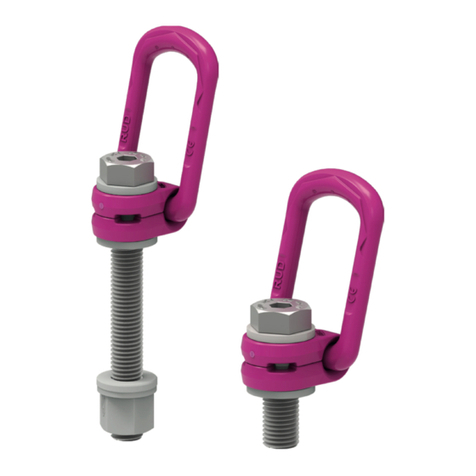
2VWBG-V in pink
Before initial usage of the RUD VWBG-V
hoist rings please read carefully the safety
instructions. Make sure that you have un-
derstood all subjected matters.
Non-observance can lead to serious per-
sonal injuries and material damage and
eliminates warranty.
1 Safety instructions
ATTENTION
Wrong assembled or damaged lifting points
as well as improper use can lead to injuries
of persons and damage of objects when
load drops.
Please inspect all lifting points before each
use.
• Not suitable for permanent turning operations un-
der load. Lifting point cannot be turned 90° to the
bolt-on direction under full load.
• The ball bearing resp. the bush bearing disc must
not be disassembled.
• The load ring must not be bend.
• RUD VWBG-V lifting points must only be used by
instructed and competent persons considering
BGR 500 / DGUV 100-500 and outside Germany
noticing the country specic statutory regulations.
2 Intended use of VWBG-V
RUD VWBG-V lifting points must only be used for the
assembly at the load or at lifting means.
They are intended to be hinged into lifting means
and can be turned under load, but not under full load,
especially not in the 90° direction. Not suitable for
permanent turning operations under load.
RUD VWBG-V lifting points can also be used as las-
hing points to attach lashing means.
RUD VWGB-V lifting points must only be used in the
hereby described operation purpose.
3 Assembly- and instruction manual
3.1 General information
• Capability of temperature usage:
Usage at higher temperatures is not recommended
due to the grease lling in the ball bearing. Should
this though be necessary, the working load limit
(WLL) of the VWBG-V must be reduced as follows:
-40°C up to 100°C no reduction
100°C up to 200°C minus 15 %
200°C up to 250°C minus 20 %
250°C up to 350°C minus 25 %
Temperatures exceeding 350°C are prohibited!
Please pay attention when using DIN EN 7042
(DIN 980) nuts the max. operation temperature
of 150°C (acc. to DIN EN ISO 2320).
• RUD VWBG-V lifting points must not be used with
aggressive chemicals such as acids, alkaline so-
lutions and their vapours.
• Please mark mounting position of lifting point with
a coloured contrast paint for better visibility.
3.2 Hints for the assembly
Basically essential:
• The material construction to which the lifting point
will be attached should be of adequate strength to
withstand forces during lifting without deformation.
The German testing authority BG, recommends
the following minimum for the bolt lengths:
1 x M (thread diameter) in steel
(min. quality 235JR [1.0037])
1,25 x M (thread diameter) in cast iron
(e.g. GG 25)
2 x M (thread diameter) in aluminium
2,5 x M (thread diameter)
in light alloys of low strength
(M = thread size/diameter, e.g. M20)
• When lifting light metals, nonferrous metals and
gray cast iron the thread has to be chosen in such
a way that the WLL of the thread corresponds to
the requirements of the base material.
• The position of the lifting points must be carried
out in such a way that unintended movement like
turning or ipping will be avoided.
• For single leg lifts, the lifting point should
be vertically above the centre of gravity of
the load.
• For two leg lifts, the lifting points must be
equidistant to/or above the centre of gravity
of the load.
• For three and four leg lifts, the lifting points
should be arranged symmetrical around
the centre of gravity, in the same plane if
possible.
• Load symmetry:
Determine the necessary WLL of each lifting point
for a symmetrical or an unsymmetrical load by
using the following physical calculation formula:
Number of load bearing strands:
Symmetric Unsymmetric
two leg 2 1
three / four leg 3 1
Chart 1: Load bearing strands
WLL = necessary WLL of lifting point / single strand
G = weight of load
n = number of load bearing strands
ß = inclination angle of single strand
WLL=G
n x cos ß

























